As someone who lived in Japan for several years, and has yet to find a permutation of sugar that I do not love, I miss the extraordinary array of sweets that were available over there that aren’t available outside the country.
We’ve also got a complete list of every (we think) Japanese subscription box available.
Sakuraco Japanese Snack Box Unboxing Video
My wife and I started by doing a little unboxing video of the Sakuraco Box.
Sakuraco Box Taste Test
- Sakuraco Japanese Snack Box Unboxing Video
- Sakuraco Box Taste Test
- Why Would You Want A Japanese Treats Subscription Box?
- Is the Sakuraco box any good?
- Things we liked about the Sakuraco box
- Things we didn’t like so much about the box
- So is the Sakuraco box worth it?
- How much does the Sakuraco box cost?
- What about Shipping?
- Who would enjoy a Sakuraco Box?
- How does the Sakuraco Japanese sweet box subscription work?
- What’s inside a Sakuraco Japanese sweets subscription box?
- Japanese Tea
- Japanese Cakes
- Mochi, Manju & Yokan
- Seasonal Japanese Treats
- Sakuraco Exclusives
- Japanese Home Goods
- A look at each of the items included in our sample box:
- Mt. Fuji Owan Bowl
- Sencha With Matcha Tea x 2
- Red Fuji Cookies x 2
- Kyoho Grape Chocolate Crunch x 2
- White Peach Milk Manju
- Uji Matcha Tiramisu Baumkuchen
- Kabocha Pudding Bread
- Green Tea Leaf Cookies
- Green Tea Dacquoise
- Castella Roll Cake
- Awase Fruits Jelly
- Kinako Mochi
- Kokeshi Doll Senbei x 2
- Ajishirabe Senbei x 2
- Edamame Senbei x 2
- Almond Mochi Four Seasons Senbei x 2
- Ototo Soy Sauce Chips
- Miso Arare
- Who is Sakuraco?
- Final Thoughts on the Sakuraco box
Why Would You Want A Japanese Treats Subscription Box?
When I’m back in Japan I make sure I find an excuse to venture down into one of the labyrinthine food emporiums you find hiding, as if to emphasize their dragon’s-hoard-of-gold style secret nature, in the basements of many Japanese department stores. I like to drift through the aisles of open-plan shop fronts like a bee through a field of sunflowers. The seemingly endless, and ever expanding, range of wagashi Japanese sweets you find in these places is enough to make you wonder if there shouldn’t be a hobby in Japan that is similar to bird watching, or trainspotting, for the rapturous observance of these Japanese delicacies.
Ok, I admit it, I’m less a sweet watcher than a sweet gobbler. Or at least a sample gobbler, a shameless freeloading glutton for the free taste testers naively offered up by the shopkeepers that man the display cases within these cakey utopias.
Luckily, the fashion for subscription boxes of all kinds, from gin to gym, has provided several options for keeping you acquainted with the magnificent world of Japanese sweets from afar.
The people over at Sakuraco, one of the recent entries into the market, were kind enough to send me out one of their boxes. Or to my household for us to try. My Japanese wife, and my insatiable children, helped me in assessing the contents.
It’s a tough job, eating soft sweeties, but someone’s got to do it.
I’ll go into the details of our, erm, rigorous, scientific testing below. But first, let me go ahead and give you the verdict.
Is the Sakuraco box any good?
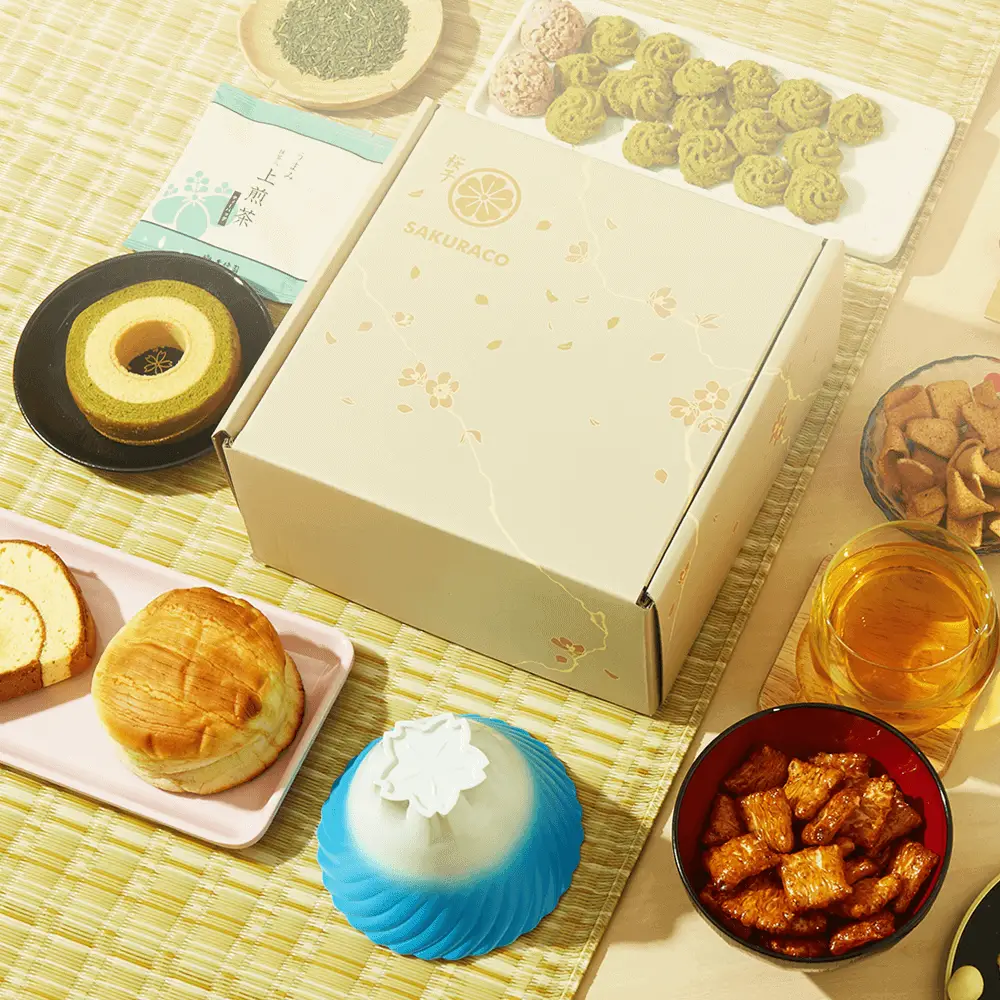
Yes, our whole family liked the sakuraco sweets box. The sweets were all of a high quality, nicely presented and tasty.
I guess the fear with these sorts of boxes is that you fork and spoon out a bunch of money and get a box filled with items that someone had hastily stacked into a plastic shopping basket at the 100 yen shop. Not so this box. These Japanese snacks had a little more class and decorum, thank you very much.
Things we liked about the Sakuraco box
But enough of the flowery prose. Let’s talk nuts and bolts:
- Our box had a beautiful presentation with a luxurious feel to it. You really get the sense that you are receiving a special present in the mail.
- There was a good range of sweeter things, salty snacks, different textures and tastes. The inclusion of a cute little Mt. Fuji bowl was a fun addition too.
- Many of the items included two portions, meaning that you don’t have to play a game of rock, paper, scissors to decide who gets the next treat.
- It’s cool that the box includes a glossy brochure giving you a little background on each of the sweets, a little info about some of the makers, and some more generic cultural information. The brochure tells you a list of possible allergens – written in English. For some people this is probably more than a “nice inclusion”, possibly even life saving.
- Each item also said whether it was Vegetarian or not. Of these, probably around 70% were listed as being vegetarian. It is hard to know exactly the term “vegetarian” was being defined. None of the items actually had any meat in them, so I assume that other items such as eggs and dairy products were not being counted as vegetarian friendly. It would be clearer for everyone if they divided things into “vegetarian” and “vegan”. Or had a column saying “vegetarian/vegan” that listed possible items of concern, such as eggs, milk, stock, so people can make up their own minds…but now we’re probably getting into the category of things we didn’t like so much about the Sakuraco box…
Things we didn’t like so much about the box
In the corporate parlance, here is the “developmental feedback”:
- There wasn’t a lot of tea in the box. Two tea bags to be precise. That’s not a lot of the green stuff to last a month, or to go with 20 different sweets for that matter. You’re going to be in trouble if you’ve got more than one friend to invite to the tea ceremony.
- That being said, tea, Japanese and otherwise, isn’t really that hard to come by in most places these days so it’s not a huge issue. Still, if you’re going to sell a luxurious box, why not a pack of 10-20 or a parcel of loose leaf.
- The extra, non-food item in our box was cute and fun, but did feel a little “plasticy” or “cheap”. Once again, not a huge issue.
- Even though you get two portions of many of the sweets, it’s not great for families. Would be good to see a “family sized” box option.
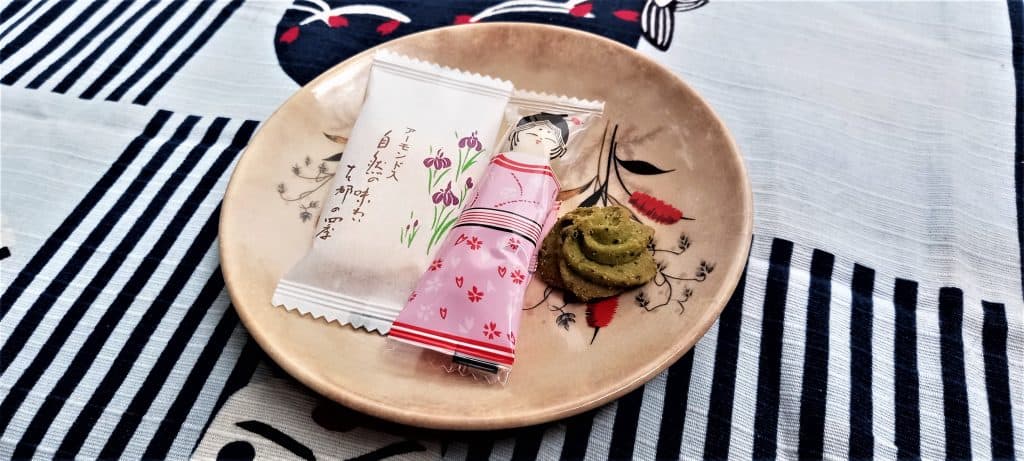
So is the Sakuraco box worth it?
To me, I think the sakuraco box is pretty reasonably priced. I asked my Japanese wife whether she thought the price was what she would expect to pay, and she seemed to feel it was.
A tick of approval from a sweet-eating native is a good sign.
As to whether you could buy all the items in Japan for a cheaper price, well probably. But that is the nature of the business. You’re paying a mark up for the convenience of someone selecting and giving you access to items you wouldn’t have otherwise. You’ve also got to factor in the fact that you get a nice glossy brochure with all the details of the snacks, and trendy little postcard from the snack-curator (which, incidentally, has to be probably the greatest job around). And you’re saving time right?
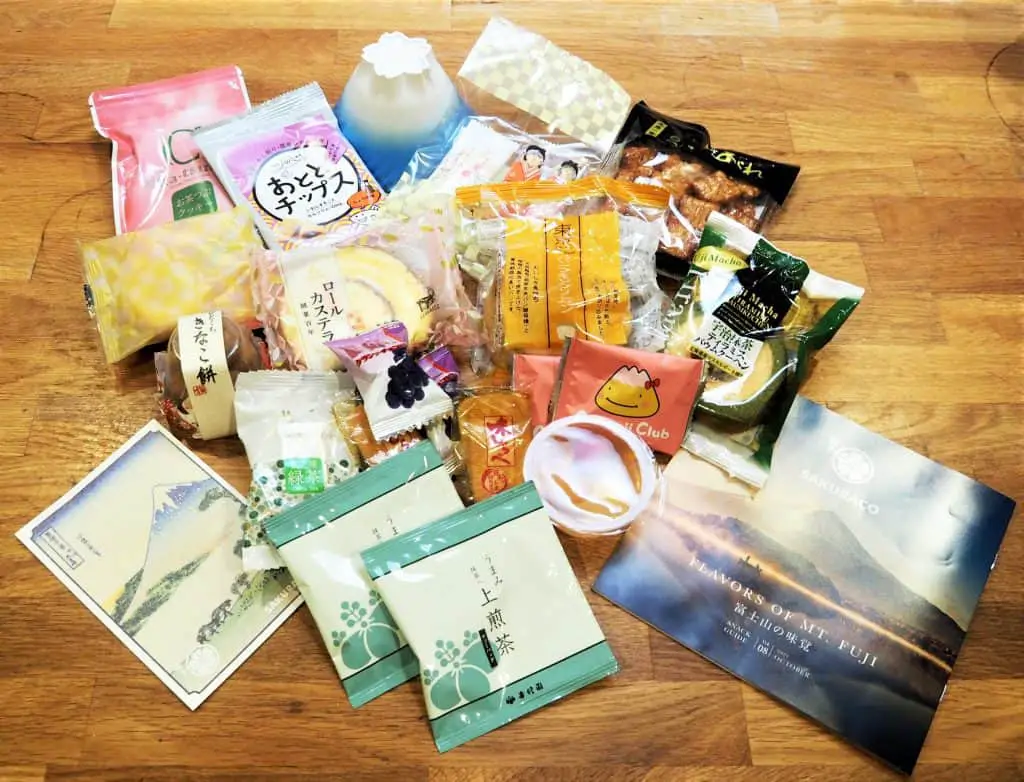
How much does the Sakuraco box cost?
There are a few options for purchasing a one off or subscription to a Sakuraco box, depending on how long you are willing to sign up for. As you would expect, the longer you commit to, the more you will save.
As of the time of writing, the prices (excluding shipping) are:
1 month – USD 37.50 / month (charged every month)
3 months – USD 35.50 / month (charged every 3 months)
6 months – USD 33.50 / month (charged every 6 months)
12 months – USD 32.50 / month (charged every 12 months)
What about Shipping?
Shipping costs are not included in the subscription charges listed above, and vary from place to place. Generally, you can expect to pay another $10-$13 on top of what you have paid for the actual box.
I’m in Australia, and my box only took a few days to arrive via DHL Express. You can track the box on it’s way to you.
My box was well wrapped in bubble wrap and a sturdy box, meaning everything inside was in pristine condition.
Who would enjoy a Sakuraco Box?
Overall, the items in the box seemed much more orientated to “adult” tastes than younger ones. In my family, the kids still enjoyed ripping open the packets and tucking into the contents. But many of the flavors are quite “subtle”, contain some element of bitterness, sometimes “fishy” flavors.
This isn’t in any way a criticism. In many ways, these are all hallmarks of the flavor associated with Japanese food in general, and Japanese sweets in particular. They’re the reason you are looking into getting a Japanese Snack Box in the first place aren’t they?
If you are looking for a box that gives you, say, the Pocky and chocolate kinako mushrooms style of sweeter, child-orientated dessert snack box, this isn’t it. You’d be better off going with something like Sakuraco’s sister box, the Tokyo Treat Box, which has all the sweet sweet stuff.
How does the Sakuraco Japanese sweet box subscription work?
The Sakuraco Japanese sweet box subscription is a monthly subscription that delivers high-quality, authentic Japanese snacks to your doorstep. It’s curated by experts in order to include the classics as well as some new flavors you’ve never tried before.

What’s inside a Sakuraco Japanese sweets subscription box?
The Sakuraco box comes with 20 snacks inside, and another “special extra” item. The
Japanese Tea
- Matcha, Hojicha & Seasonal.
Japanese Cakes
- From Castella to Taiyaki.
Mochi, Manju & Yokan
- Traditional Japanese Sweets
Seasonal Japanese Treats
- Sakura, Momiji etc.
Sakuraco Exclusives
- Senbei and Konpeito by Local Makers
Japanese Home Goods
- Ceramics, Chopsticks & Furoshikis.
A look at each of the items included in our sample box:
Mt. Fuji Owan Bowl
By Tanaka Hashiten (Fukui)
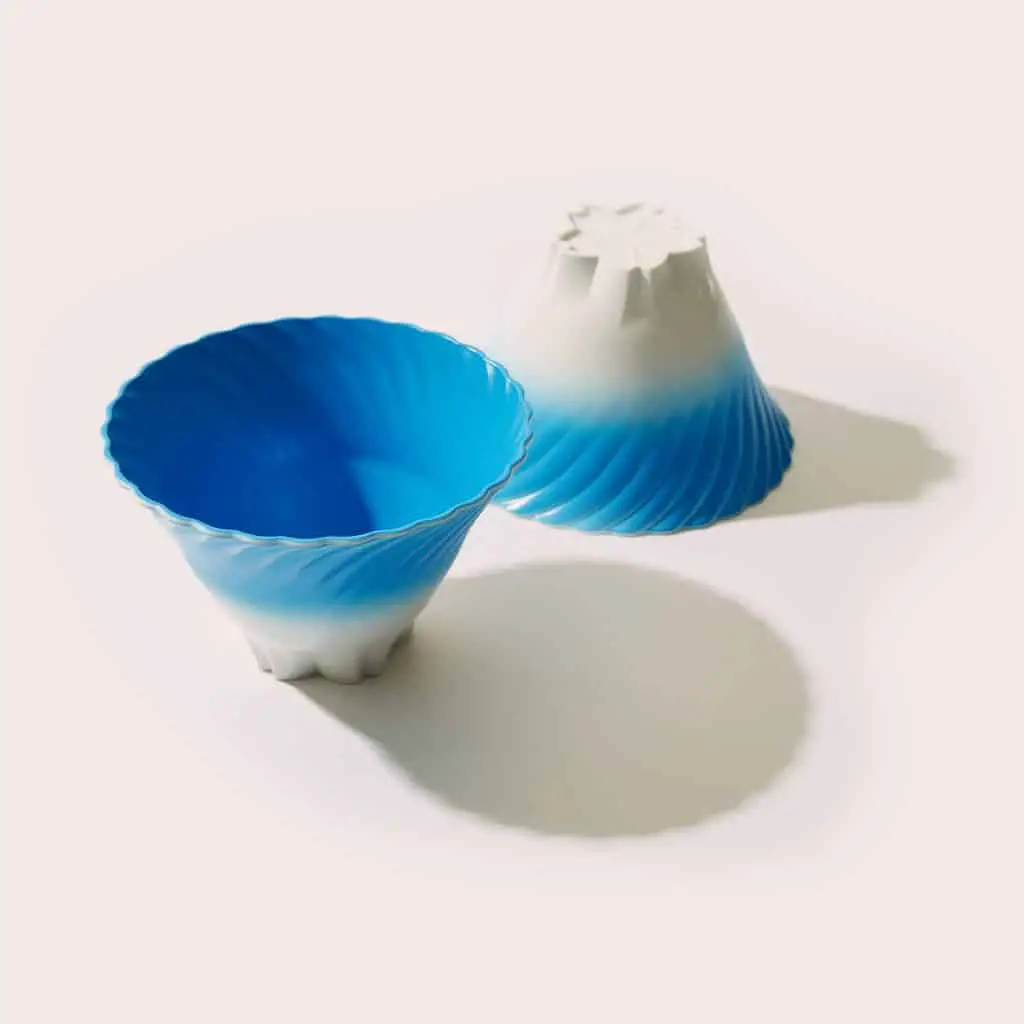
“This owan bowl was designed in honor of the sacred Japanese mountain. Use it for snacks and sweets, or flip it upside down as décor.”
This one bowl was kind of fun. It was a bit plasticy feeling, so I question how likely you would be to use it as “decor”. I felt like it would have been better as something for the kids. In fact, my kids did come up with what I feel is the best use case scenario we have come up with so far – a kakigori, sweet shaved ice bowl.
Sencha With Matcha Tea x 2
By Brooks (Kanagawa)

“Enjoy the sweetness of matcha powder mixed with the umami power of sencha roasted tea for a truly unique tea drinking experience. “
I liked this tea. It was quite a subtle flavor, not at all bitter or overpowering, but with a satisfying after note. It was a shame there were only the two tea bags though…
Red Fuji Cookies x 2
By Matsuzawa (Nagano)

“Delicate chocolate almond sugar cookies in the shape of the iconic mountain. The light pink icing is flavored with sweet strawberry.”
The flavor of this one stumped my wife and I. It’s only after you look at the blurb that tells you what is in it that you go, “yes, that’s it I tasted that and that and that, I think, yes, I’m sure that must be right”. It was a complex malaise of flavors that my mouth is still confused about a week later. I think I might need to eat another ten of these to find some culinary closure.
Kyoho Grape Chocolate Crunch x 2
By Izumi Bussan (Ishikawa)
“Kyoho grapes from Yamanashi are highly prized for their rich flavor. This crunchy sweet is made with smooth white chocolate infused with fragrant grapes and coated around toasted corn flakes.”
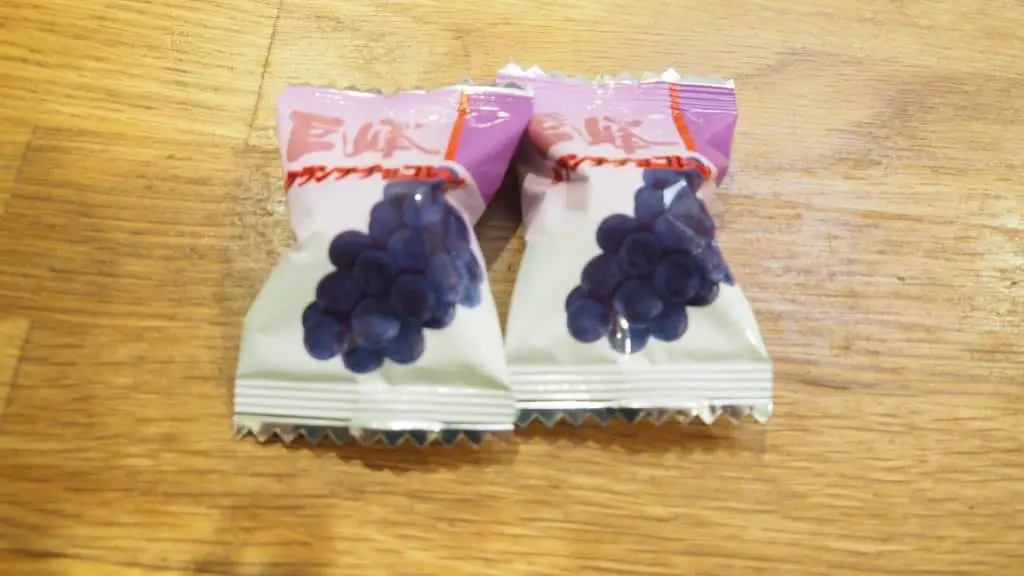
I’ve been to Yamanashi about five times, but for some reason the “highly prized” Kyoho grape has managed to elude me. So I can’t attest as to whether this tasty little morsel pays appropriate homage to the original fruit. In fact, I’m ashamed to say that my reference for this intriguing textural mix of crispy, chocolaty, fruity elements is, well, cereal. It was like I was enjoying breakfast all over again, but condensed down to the size of, say, a tiny bird’s egg, or an extra large blueberry. Or perhaps a particularly big Kyoho grape, however big they are.
White Peach Milk Manju
By Matsuzawa (Nagano)
“This steamed milk manju is filled with a sweet white peach, a specialty from Yamanashi Prefecture, the highest producer of the fruit in Japan.”
This one has so many different variations of “soft” about it. It’s the culinary equivalent of sleeping on a queen size bed three mattresses high, fine sheets and a duvet.
Uji Matcha Tiramisu Baumkuchen
By Kashihara (Tokyo)

“This baumkuchen, which is made by slowly adding layer after layer of batter on a rotating spit, is a beautiful Japanese twist on tiramisu flavor: fresh cream flavor but with matcha instead of coffee. Uji matcha is considered the highest quality of green tea and is grown in mountains outside of Kyoto.”
Ok, I admit I have no idea what a baumkuchen is. If someone had asked me, I would have guessed it was a German car.
Tiramisu is in my wheelhouse though. And I’m all for switching up the coffee flavor with matcha, as hard to beat as the choc-coffee combo is. I feel this was a successful experiment, but would probably benefit from being eaten fresh, rather than shipped half away around the world in an airlocked plastic bag…
Kabocha Pudding Bread
By Tokyo Bread (Fuji)
“Kabocha is Japanese pumpkin, which has a milder and sweeter flavor than its North American cousin. This bread is made with brown rice yeast and has rich pumpkin puree and pudding folded into the dough for a moist and rich fall treat.”

I would like to faithfully report back on this one, given as this was perhaps the sweet I was most looking forward to in the box, with its fluffy, spongy, bready looking exterior. But, alas, my kids got to it before me. Which is strange, because they don’t even like pumpkin…
Green Tea Leaf Cookies
By Takayanagi (Shizuoka)
“These beautiful butter cookies are made with whole tea leaves sourced from Makinohara, Shizuoka Prefecture. Their crisp texture is perfect for an afternoon tea break.”
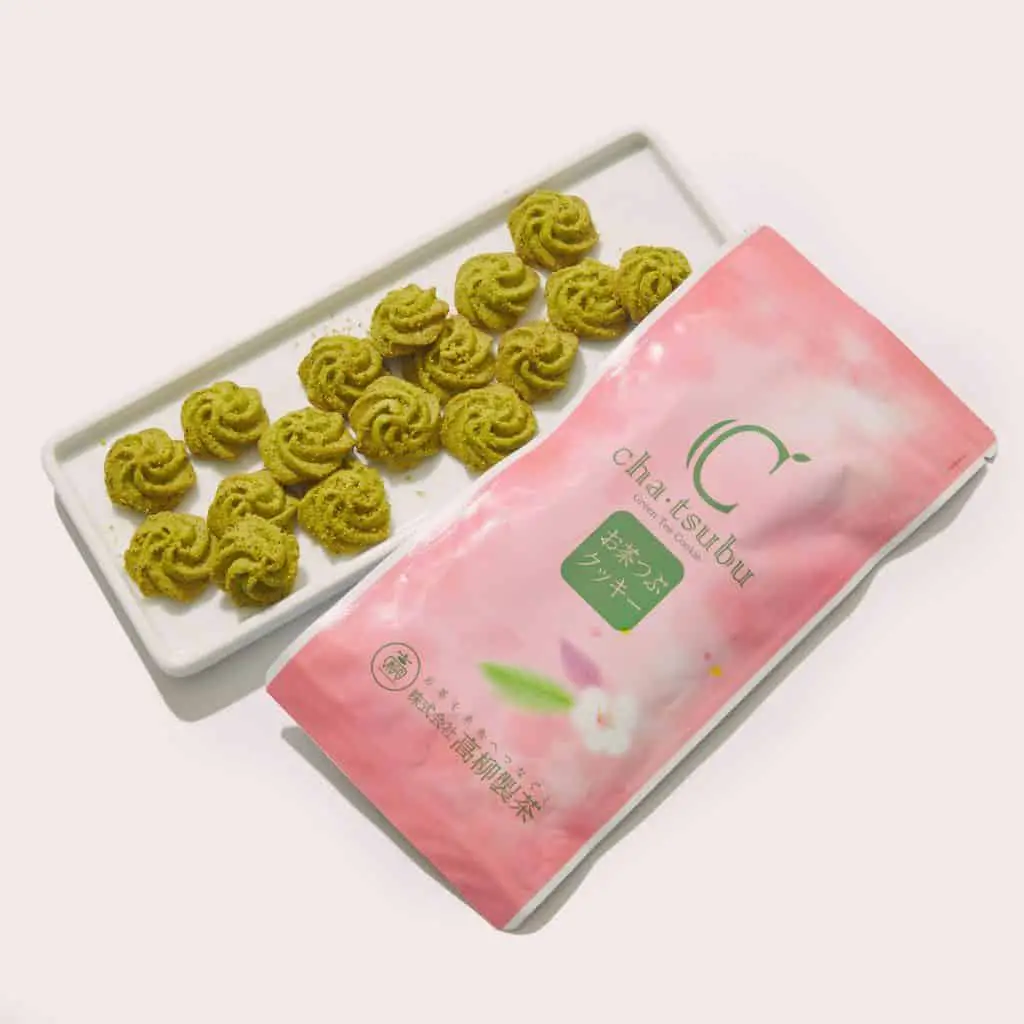
These crumbly-in-a-good-way cookies had a flavor so subtle that I must admit I barely detected it. My wife reassured me by saying that I was a culinary heathen and that these little green tea tasting morsels were bite-sized pearls before swine. That didn’t make them taste any better to me, or improve my self-esteem, but after eating three of them I felt like I had accumulated enough flavor to assemble an adequate, cumulative assault on my taste buds.
Green Tea Dacquoise
By Takayanagi (Shizuoka)
“Indulge in sweet matcha cream sandwiched between two green tea infused meringues. This elegant dessert is made with rice flour and green tea from Makinohara in Shizuoka.”
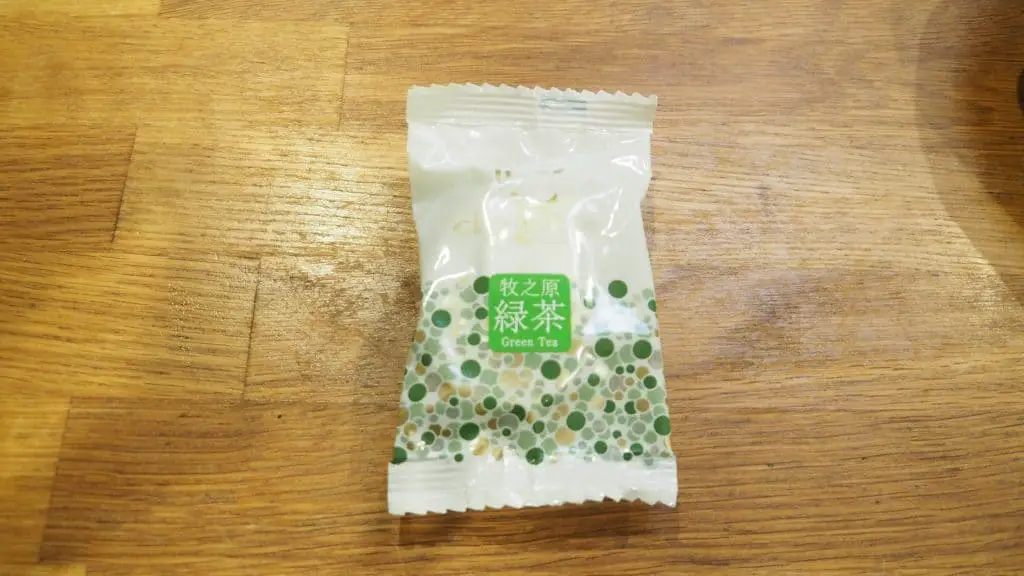
I know about as much about a meringue as I know how to spell it. But biting into this one gives you a deeply satisfying combination of crisp and snappy, with soft and creamy. What’s not to love about the sandwich format – sweet or savoury?
Castella Roll Cake
By Sanseisha (Osaka)
“Castella cake was originally brought to Japan by the Portuguese in the 16th century and soon became a beloved dessert. This sweet roll cake version is filled with a rich buttercream; perfect for an afternoon treat.”
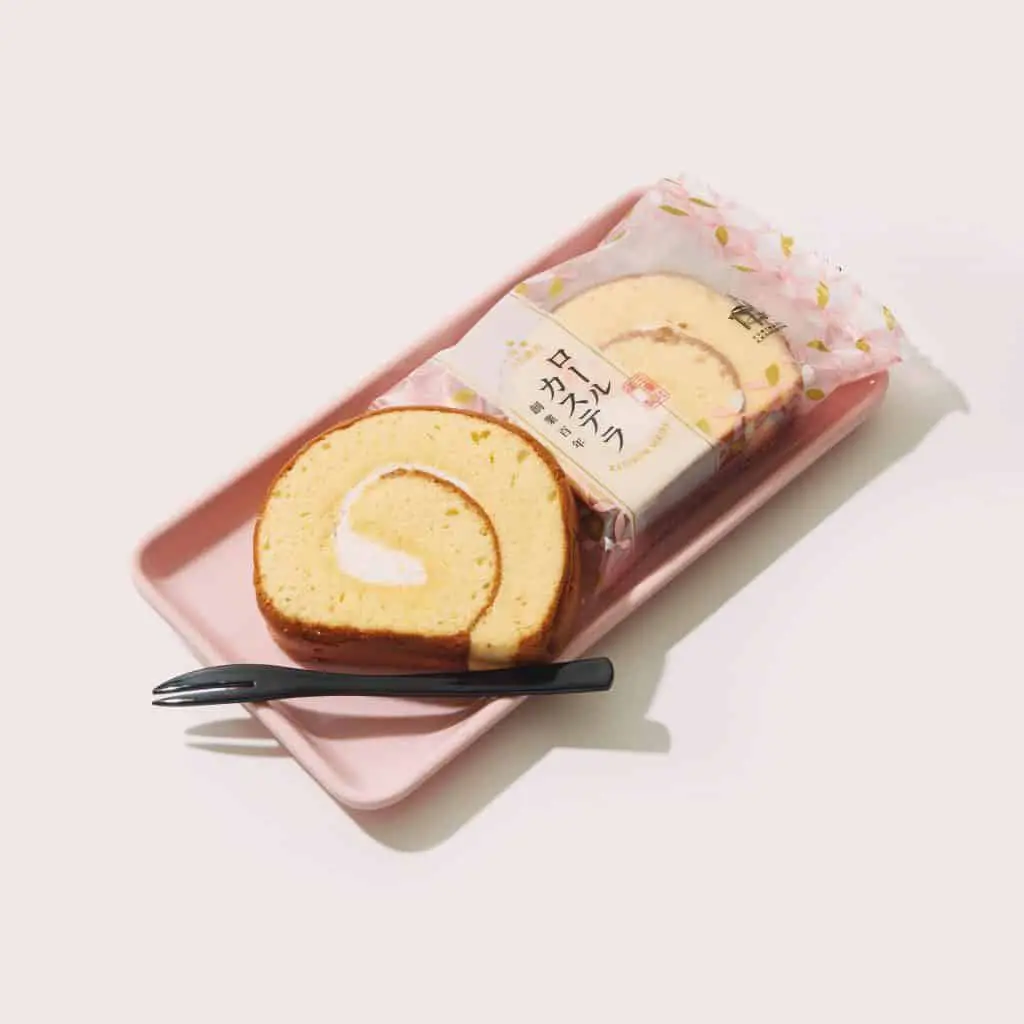
To me, the Castella is one of those classic “big in Japan” things. But a Portuguese person may beg to differ, especially if they had been transported from the 16th century. Where I come from, we call a sponge a sponge. But I have to admit that the castella does have a level of firmness about it that sets it apart and makes it a more fulfilling, satiating experience than it’s springy spongy cousin.
Awase Fruits Jelly
By Morihaku (Gifu)
“Made with the regional specialty of sweet Yamanashi cherries, along with refreshing mikan orange and apple, this jelly is bursting with fresh fruit flavor.”
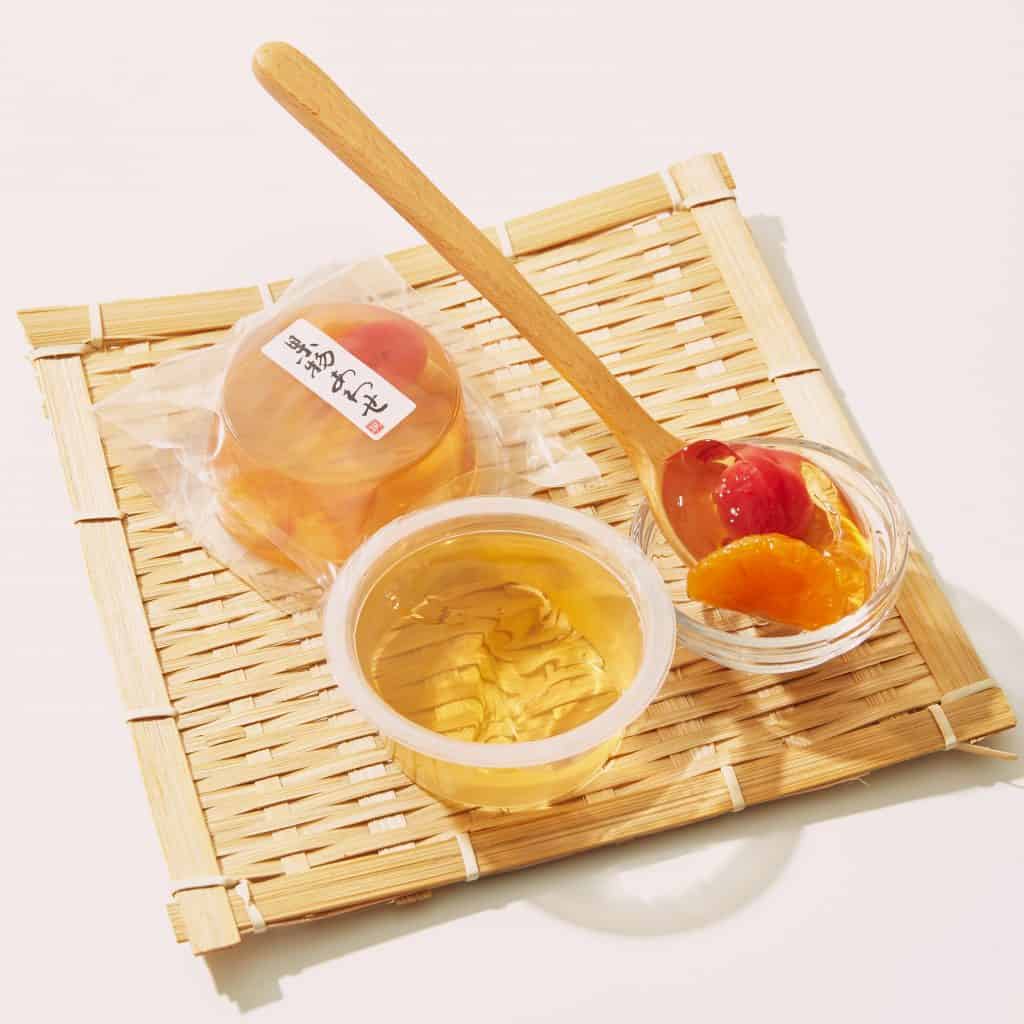
This little jelly treat screams summer. Or spring. Or something sunny and tangy and citrusy at any rate.
I shlurped this one down in the time it takes most people to sneeze.
My only bone to pick (metaphorically), was that “awase” means “combination” and in my books, two fruits do not a combination make. Ok, if they had tried to squeeze any more fruit in the little packet, the whole fruit to jelly ratio would have been all out of kilter. Which reminds me, I actually did have another bone to pick. The package. It looked like airline food, and gave me horrible memories of opening hard-to-peel lids from plastic containers at altitudes several thousands of feet in the air and several 10s of feet from the place where your change of clothing is stowed (for when you inevitably spill the contents of your container onto your trousers when attempting to prise the lid in your cruelly apportioned economy seating).
Kinako Mochi
By Aokikou (Nara)
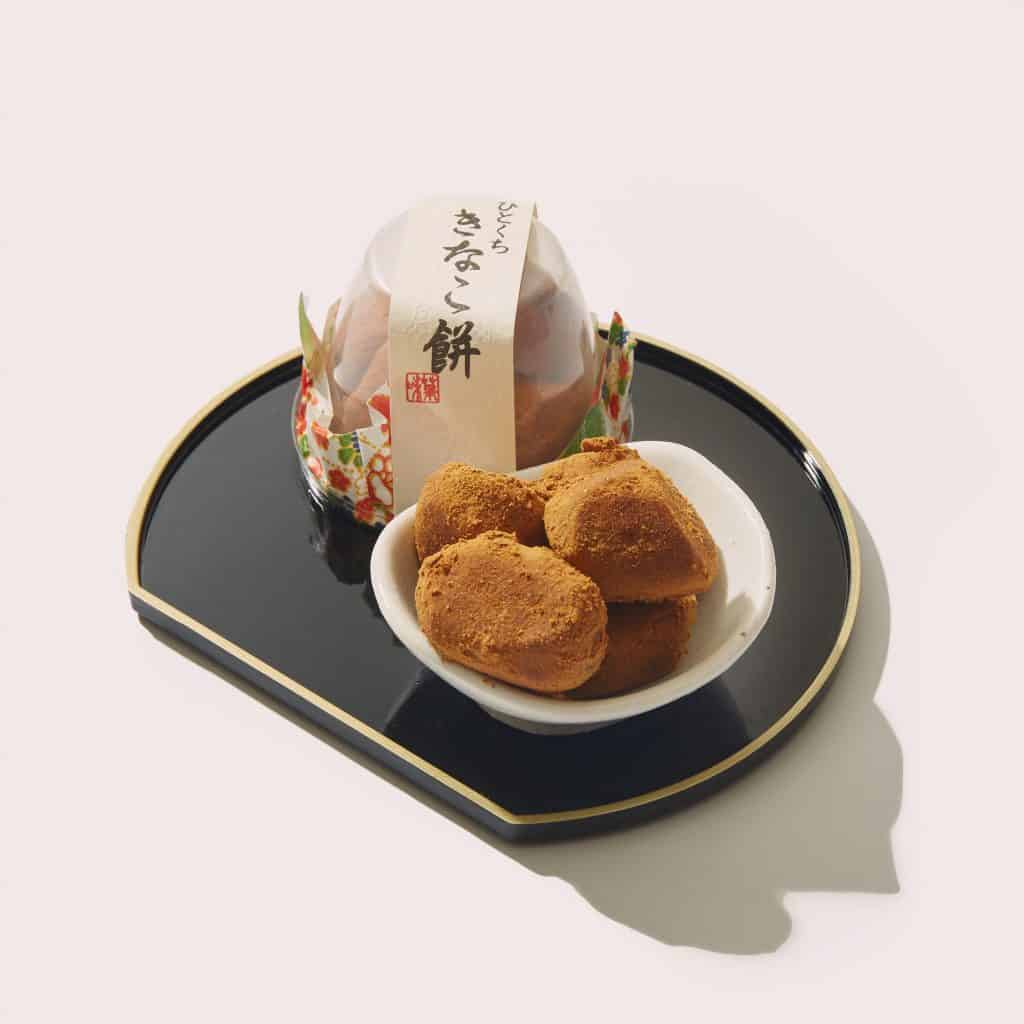
“Made from glutinous rice flour, this kinako mochi is dusted by skilled craftspeople with roasted soybean flour mixed with sugar. This gives the mochi a subtle nutty flavor that pairs well with tea.”
Kinako is a mystery to me. When I first tried it in Japan as a teenager, I felt like a Spanish conquistador who had crossed the oceans and discovered the magic spice that the old world sages had been speculating about for centuries.
It also intrigues me because it reminds me so much of cinnamon, and we don’t seem to have an equivalent in the west.
Anyway, suffice it to say, if it involves Kinako I’m there. Dust it onto a soft-as-mochi-hada-skin mochi ball and I’m just going to lose my anko.
Kokeshi Doll Senbei x 2
By Morihaku (Gifu)
“Kokeshi dolls are a traditional Japanese folkcraft that started as toys for children. These rice snacks mimic the shape of the dolls with cute and decorative packaging. The head is a roasted peanut, while the body is soy sauce flavored.”
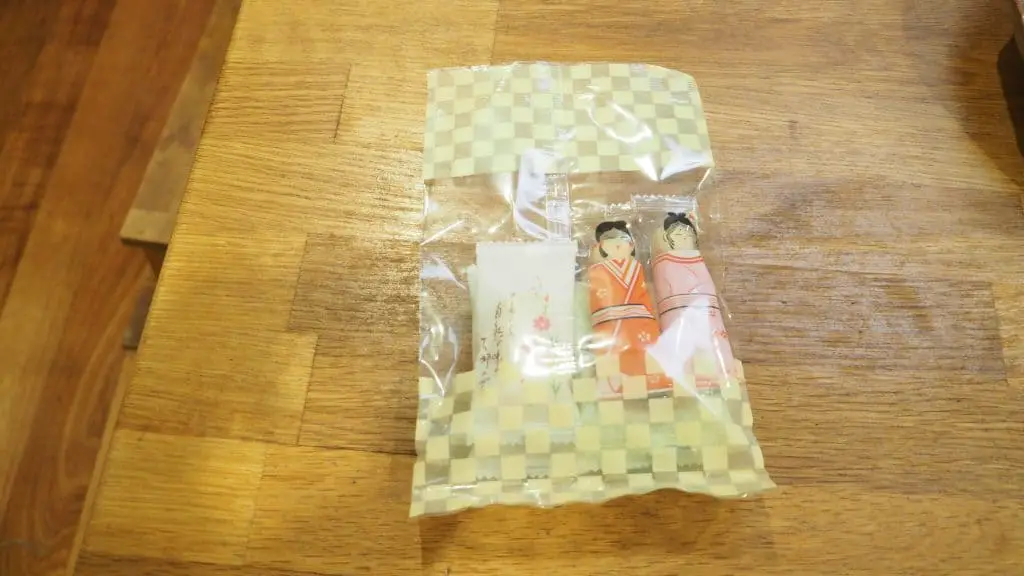
This one was the prettiest and most interesting looking of the bunch for me, with two little snacks standing to attention in their packs as cute-as-a-button kokeshi dolls. I must admit that I was a little disappointed that when I opened the pack, I found that the effect had been achieved by combining a standard senbei style rice cracker with one of those coated roasted peanuts you get in Japan. I like both of those things, so it wasn’t a big deal, but I guess I felt like I had turned up to a date with someone I had met over the internet that presented as being 15 years older than the profile picture they had posted on their online profile. The illusion was fun while it lasted though…
Ajishirabe Senbei x 2
By Masakiya Confectionary (Niigata)
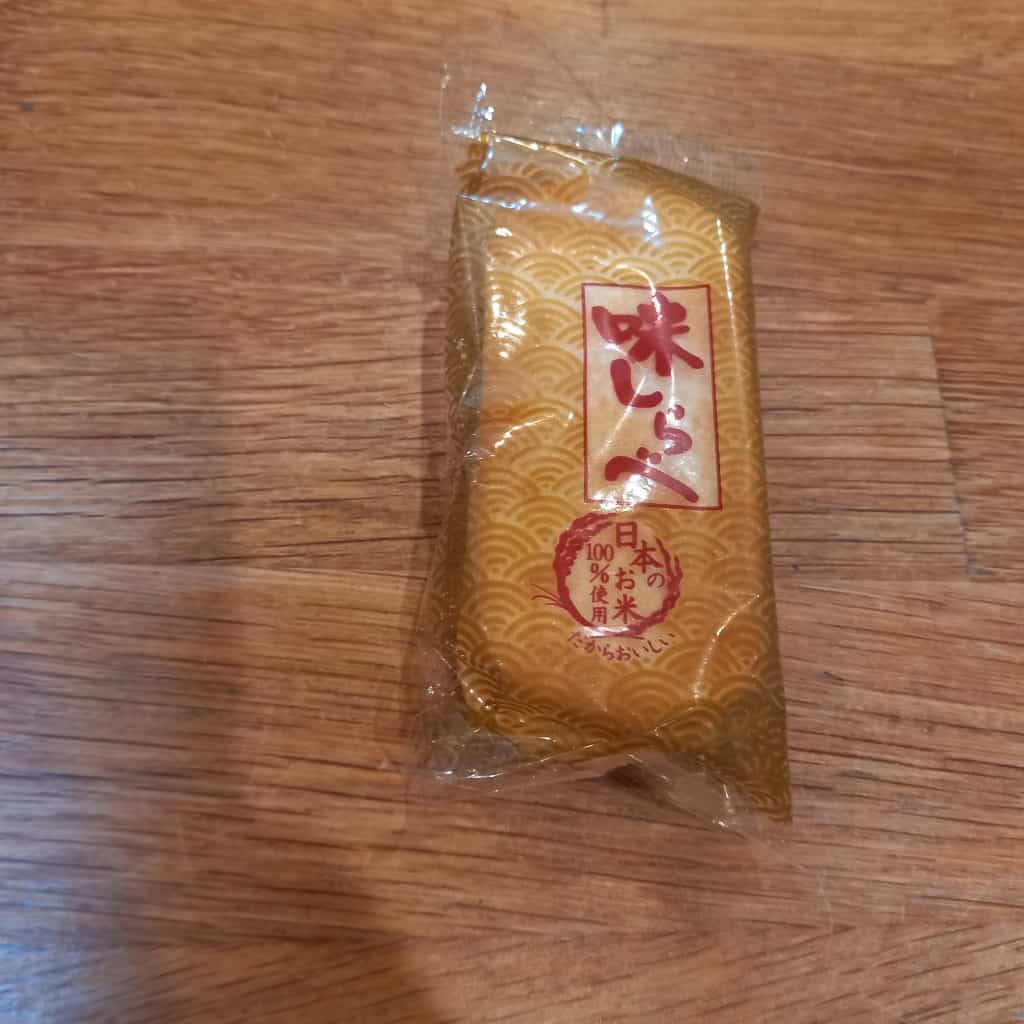
“Made with Niigata rice, the prefecture that wins the best rice awards year after year, this classic rice cracker is lightly toasted and salted. The perfect savory snack to pair with a roasted green tea.”
Aji means flavor and shirabe means investigation, so I quickly dubbed these crackers “flavor investigations” and got right down to investigating them myself. Actually, these struck me as being pretty standard senbei style snacks, standard enough that I’m not sure the particularly warranted the investigation.
Edamame Senbei x 2
By Morihaku (Gifu)
“This rice cracker’s green color is from ground edamame beans. Onceall edamame and eggs are fully incorporated into the dough, it is pressed and then lightly toasted to perfection.”

Is there nothing an edamame can’t do? How did any bean come to be so damn tasty? This my friends is a mystery that cannot be solved. You’ve got to go with it. Don’t question, or overthink it.
Edamame, we love your work.
Almond Mochi Four Seasons Senbei x 2
By Morihaku (Gifu)
“This fragrant rice cracker is made by kneading almonds into the dough made with glutinous rice flour. Once incorporated, it is baked to a rich, golden brown.”
I love senbei with nuts in them. It’s the soft-crunch, hard-cruch combo that does it. This particular cracker of a little senbei did it quite well indeed.
Ototo Soy Sauce Chips
By Mizutani Shoten (Shizuoka)
“These chips are made with okara, a soybean pulp that is a bi-product of the tofu-making process and are flavored with iwashi sardine shavings, local to Shizuoka.”

Look, I’m just going to say it. This recent trend to make chips out of anything but a potato, such as kale, or sweet potato (painfully, teasingly close) or carrots, is not one that makes me feel love. So I’m torn here, as these chips are actually quite tasty, but I feel bound to condemn them out of principle. Or at least I will once I’ve finished the pack.
Miso Arare
By Kikuichi (Aichi)
“These crispy rice snacks are made with ingredients from Aichi Prefecture, from the rice to the tamari soybean sauce and red miso seasoning. Baked to a rich golden color, they are the perfect blend of sweet & savory.”
Miso is at one with the miraculous paste of hummus in being an mushy substance that invincibly goes with any food stuff known to man. These arare simply prove the point. And you sure aren’t going to find hummus arare in a hurry, so you better take your kicks where you can.
Who is Sakuraco?
Sakuraco is part of a suite of brands selling a range of Japanese subscription boxes and other products. Their Tokyo Treat box has Japanese style sweets that are closer to western confectionery, while the Sakuraco brand focuses on more subtle and refined flavors.
Other brands include the Yume Twins box, which gives a box of kawaii-cute stuff from Japan every month. There is Japan Haul, which sells a range of Japanese food, drink and snacks individually.
The suite of brands even features Tokyo Catch, an intriguing mobile casual-gaming app where you can win real-world prizes.
Final Thoughts on the Sakuraco box
Overall, my blended Japanese family and I were impressed with the Sakuraco box. Whether or not it is worth the price tag once postage is factored in will be a personal decision. The snacks are authentic, traditional items aimed at an adult pallet. So it really depends on how dedicated you are to the refined art of afternoon tea, Japanese style.
I am a fan of the Twin Peaks TV show, which features the detective character “Coop” who says in one of the episodes “You’ve gotta give yourself a little gift every day”. Having a box of little treats at your fingertips is a good way to do that. The portions are small and are not nearly as sugary as a big ol’ pack of candy either. So it’s probably a healthier option than snacking on junk on a daily basis.
I also think these boxes, with their beautiful presentation and luxurious feel, make great Japanese gifts – either as a one-off box on a special occasion or as a series of boxes delivered to your loved one over several months.
My advice is to start with a single box, see how you like it. You’ll also get a sense of how having the box fits in with your daily routine. Do you chew through the whole box in a few days or does it last you through the month? Do you find yourself liking every item or only every third item? Does it fit your tea/coffee-taking routines and rituals? That might take a cup of tea or three for you to ponder over…
